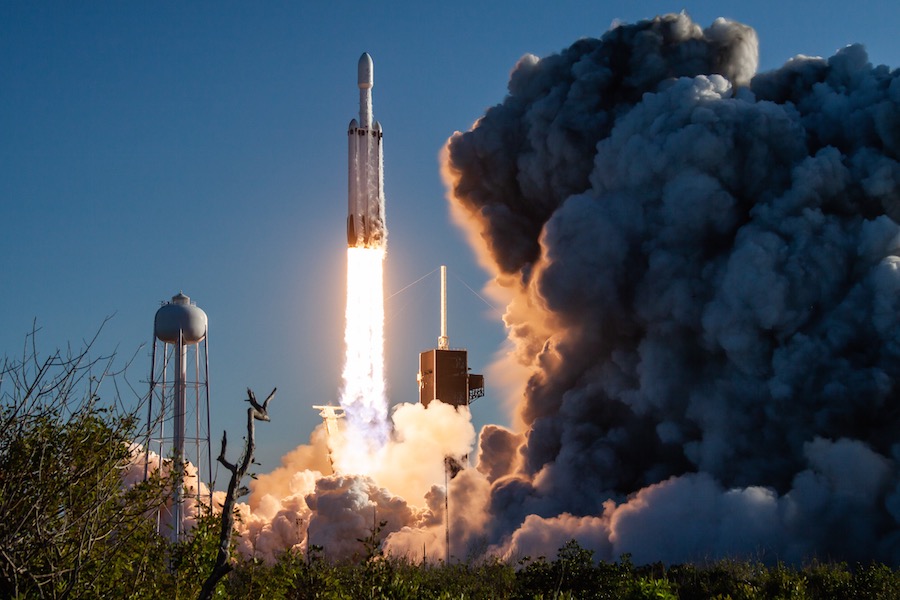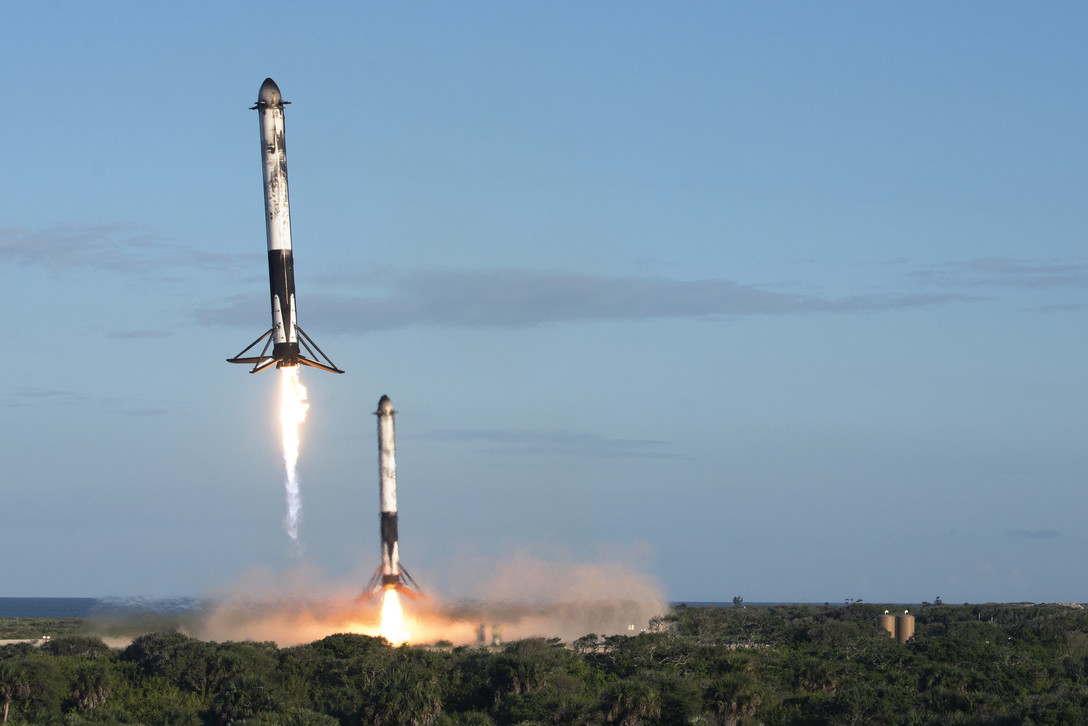Space News & Blog Articles
After a three-year wait, SpaceX’s Falcon Heavy could launch again later this month
 SpaceX’s second Falcon Heavy rocket lifts off from pad 39A on April 11, 2019, with the Arabsat 6A communications satellite. Credit: Walter Scriptunas II / Spaceflight Now
SpaceX’s second Falcon Heavy rocket lifts off from pad 39A on April 11, 2019, with the Arabsat 6A communications satellite. Credit: Walter Scriptunas II / Spaceflight Now
More than three years after SpaceX’s Falcon Heavy rocket last blazed a path into orbit, the 28-engine launcher is finally set to fly again as soon as Oct. 28 from Kennedy Space Center in Florida on a long-delayed national security mission for the U.S. Space Force, a military spokesperson said.
The Falcon Heavy rocket mission, codenamed USSF-44, is expected to be the next launch from Launch Complex 39A at Kennedy following the liftoff Wednesday of a Falcon 9 rocket and a Dragon capsule carrying a crew of four to the International Space Station. SpaceX ground teams at pad 39A will prepare the pad for the Falcon Heavy, which has a different configuration than the Falcon 9 with three Falcon rocket boosters connected together to triple the launcher’s total thrust.
The launch is expected to occur in daylight in the morning hours, but the Space Force has not officially released the launch time for the USSF-44 mission, the fourth flight of a SpaceX Falcon Heavy rocket and the first since June 2019.
The long gap between Falcon Heavy launches has been caused by payload delays. The USSF-44 mission was originally scheduled to launch in late 2020, but has been nearly two years by issues with the Space Force payload assigned to fly on the rocket. A military spokesperson told Spaceflight Now the USSF-44 payload issues are now resolved, without offering additional details.
The Space Force has released little information about what the Falcon Heavy rocket will carry into orbit on the the USSF-44 mission.
One of the payloads assigned to launch on the USSF-44 mission is a microsatellite named TETRA 1. Built by Millennium Space Systems, a subsidiary of Boeing headquartered in El Segundo, California, the small spacecraft is designed to “prototype missions and tactics, techniques and procedures in and around geosynchronous Earth orbit,” Space Force officials said.
Military officials have released no additional details about TETRA 1’s mission.
The original procurement statement the Pentagon released to prospective launch providers for the USSF-44 mission indicated the mission would launch with two spacecraft. But that was four years ago, and the Space Force has not released any updates to the final number of satellites assigned to the flight.
In the request for proposals for the USSF-44 launch, the Air Force told prospective launch providers to assume the combined mass of the two payloads is less than 8,200 pounds, or about 3.7 metric tons. The TETRA 1 satellite alone would account for a small fraction of that mass.
The Falcon Heavy is expected to deliver the satellites on the USSF-44 mission to a high-altitude geosynchronous orbit. The rocket’s upper stage will fire several times to place the satellites into position more than 22,000 miles above the equator. The upper stage flight profile will include a coast lasting more than five hours between burns, making the USSF-44 mission one of SpaceX’s most demanding launches yet.
On the most recent Falcon Heavy mission, the rocket’s upper stage completed four burns over three-and-a-half hours on a demonstration flight sponsored by the Air Force.
The complex orbital maneuvers during the June 2019 mission for the military’s Space Test Program were required to place 24 satellite payloads into three distinct orbits. They also exercised the capabilities of the Falcon Heavy and its Merlin upper stage engine before the military entrusts the launcher with more critical, and more expensive, operational national security payloads on future flights.
SpaceX will use three newly-manufactured boosters for the USSF-44 mission. All of the boosters for the USSF-44 mission were delivered to the Florida launch base last year.
The challenging launch profile will leave no leftover propellant to recover the center core of the Falcon Heavy, according to the Space Force. The core stage will be expended on the USSF-44, while the rocket’s two side boosters will return to near-simultaneous landings in SpaceX’s recovery zone at Cape Canaveral Space Force Station, according to a spokesperson for the Space Force’s Space Systems Command.
That is a change from what the Space Force previously said. A military spokesperson said in 2021 that the Falcon Heavy’s two side boosters on the USSF-44 mission would target landing on two SpaceX drone ships floating downrange in the Atlantic Ocean.
 Two reusable rocket boosters land at Cape Canaveral Air Force Station after the successful launch of SpaceX’s Falcon Heavy rocket with the Arabsat 6A satellite April 11, 2019. (U.S. Air Force photo by James Rainier)
Two reusable rocket boosters land at Cape Canaveral Air Force Station after the successful launch of SpaceX’s Falcon Heavy rocket with the Arabsat 6A satellite April 11, 2019. (U.S. Air Force photo by James Rainier)
Tom Ochinero, SpaceX’s vice president of commercial sales, said last month the company plans six Falcon Heavy missions over the next 12 months, among a busy schedule of Falcon 9 missions flying at an average rate of more than once per week.
USSF-44, mission scheduled to blast off later this month, is the next Falcon Heavy on SpaceX’s schedule. A new-generation Viasat broadband satellite or the Space Force’s USSF-67 mission will likely be the next Falcon Heavy launch after USSF-44.
Viasat said last week that its first of three Viasat 3-series internet broadband satellites, booked to launch on a Falcon Heavy toward geosynchronous orbit, is scheduled to lift off before the end of the year. But industry sources said the first Viasat 3 launch, already delayed by supply chain issues that affected satellite and payload manufacturing, could delay into early 2023.
The Space Force said its USSF-67 mission, which the military says will launch into geosynchronous orbit like USSF-44, is currently scheduled for January. The military has not officially disclosed the payloads for the USSF-67 mission, but mission patches for the USSF-67 launch indicate it will carry the second spacecraft for the Space Force’s Continuous Broadcast Augmenting SATCOM, or CBAS, program. The first CBAS satellite launched in 2018, and officials said then the satellite was designed to relay communications signals between senior leaders and military combatant commanders.
Another Space Force satellite delivery mission booked on a Falcon Heavy, codenamed USSF-52, is now planned to launch in the second quarter of 2023 — between April 1 and June 30.
The other Falcon Heavy missions slated for launch in the next 12 months include the heavyweight Jupiter 3 commercial broadband satellite for EchoStar and Hughes Network Systems later in 2023.
NASA’s Psyche asteroid explorer, originally slated to launch in August of this year on a Falcon Heavy, has been grounded by software testing problems. NASA is reviewing plans to resolve the software issues, and the space agency will decide in the coming weeks whether to attempt to launch the Psyche spacecraft, still on a Falcon Heavy rocket, in the next available launch period in July 2023.
Despite the lack of Falcon Heavy launches since 2019, SpaceX has continued to win contracts to build its backlog of Falcon Heavy missions, which offer payload lift capability greater than the Falcon 9 but below that of the company’s next-generation Starship and Super Heavy rocket. The Falcon Heavy is powered by 27 Merlin main engines from three Falcon rocket cores connected together, generating 5.1 million pounds of thrust at liftoff and standing 229 feet (70 meters) tall and 40 feet (12.2 meters) wide.
The Falcon Heavy’s upper stage is mostly identical to the upper stage of a Falcon 9 rocket, with a single Merlin engine.
SpaceX says the Falcon Heavy rocket is capable of placing a payload of up to 140,000 pounds, or more than 63 metric tons, into a low-altitude orbit. That figure assumes the Falcon Heavy’s boosters are burned to near fuel depletion and not recovered.
SpaceX’s most recent Falcon Heavy launch contract win was in July, when NASA awarded the company a deal worth $255 million to launch the Nancy Grace Roman Space Telescope in 2026.
With the Roman launch contract in hand, SpaceX now has a backlog of up to 13 Falcon Heavy rocket missions. They include the USSF-44, USSF-67, and USSF-52 missions for the U.S. Space Force slated to launch late this year and in 2023, the launch of of NASA’s Psyche asteroid probe in 2023, the launch of NASA’s Europa Clipper in 2024 to explore an icy moon of Jupiter, and the launch of the first two elements for NASA’s planned Gateway mini-space station to orbit the moon.
NASA has also contracted with SpaceX for the Falcon Heavy to launch NOAA’s GOES-U geostationary weather satellite in 2024 and two commercial resupply missions to the Gateway later in the 2020s. The status of the contract for the Gateway logistics missions is not clear. It was signed in 2020, but NASA has not yet given SpaceX authority to proceed for preparations to begin for the Gateway resupply flights.
SpaceX has won contracts for two Falcon Heavy missions to launch large geostationary internet communications satellites for Viasat and EchoStar. And a Falcon Heavy rocket is slated to launch NASA’s VIPER robotic rover toward the moon in late 2024 on a commercial lunar delivery flight managed by Astrobotic.
This email address is being protected from spambots. You need JavaScript enabled to view it. the author.
Follow Stephen Clark on Twitter: @StephenClark1.
When you subscribe to the SpaceZE News Feed, we will send you an e-mail when there are new updates on the site so you wouldn't miss them.

